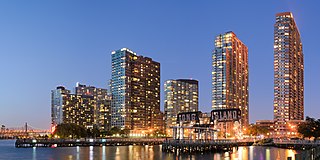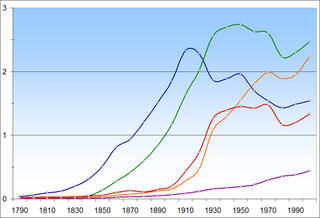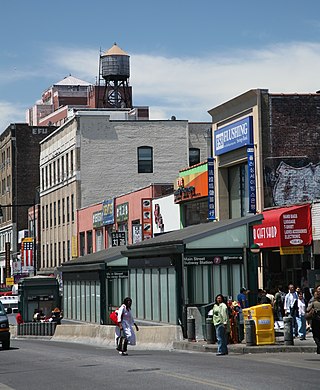Related Research Articles

A Chinatown is an ethnic enclave of Chinese people located outside Greater China, most often in an urban setting. Areas known as "Chinatown" exist throughout the world, including Europe, Asia, Africa, Oceania, and the Americas.

Queens is a borough of New York City, coextensive with Queens County, in the U.S. state of New York. Located on Long Island, it is the largest New York City borough by area. It is bordered by the borough of Brooklyn at the western tip of Long Island to its west, and Nassau County to its east. Queens also shares water borders with the boroughs of Manhattan, the Bronx, and Staten Island.

Manhattan's Chinatown is a neighborhood in Lower Manhattan, New York City, bordering the Lower East Side to its east, Little Italy to its north, Civic Center to its south, and Tribeca to its west. With an estimated population of 90,000 to 100,000 people, Chinatown is home to the highest concentration of Chinese people in the Western Hemisphere. Manhattan's Chinatown is also one of the oldest Chinese ethnic enclaves. The Manhattan Chinatown is one of nine Chinatown neighborhoods in New York City, as well as one of twelve in the New York metropolitan area, which contains the largest ethnic Chinese population outside of Asia, comprising an estimated 893,697 uniracial individuals as of 2017.

Flushing is a neighborhood in the north-central portion of the New York City borough of Queens. The neighborhood is the fourth-largest central business district in New York City. Downtown Flushing is a major commercial and retail area, and the intersection of Main Street and Roosevelt Avenue at its core is the third-busiest in New York City, behind Times Square and Herald Square.

This article discusses Chinatowns in the Americas, urban areas with a large population of people of Chinese descent. The regions include: Canada, the United States, and Latin America.
The cuisine of New York City comprises many cuisines belonging to various ethnic groups that have entered the United States through the city. Almost all ethnic cuisines are well represented in New York, both within and outside the various ethnic neighborhoods.

Woodside is a residential and commercial neighborhood in the western portion of the borough of Queens in New York City. It is bordered on the south by Maspeth, on the north by Astoria, on the west by Sunnyside, and on the east by Elmhurst, Jackson Heights, and East Elmhurst. Some areas are widely residential and very quiet, while other parts, especially the ones around Roosevelt Avenue, are busier.

New York City is a large and ethnically diverse metropolis. It is the largest city in the United States with a long history of international immigration. New York City was home to over 8.3 million people in 2019, accounting for over 40% of the population of New York State and a slightly lower percentage of the New York metropolitan area, home to approximately 23.6 million people across parts of New York, New Jersey, and Connecticut. Over the last decade the city has been growing faster than the region. The New York region continues to be by far the leading metropolitan gateway for legal immigrants admitted into the United States.

Bangladeshi Americans are Americans of Bangladeshi descent. The majority of Bangladeshi Americans are Bengalis and form the largest group of Bengali Americans. Bangladeshi immigrants have arrived in the United States in large numbers since the early 1970s to become among the fastest growing ethnic communities since that decade. New York City, home to two-thirds of the Bangladeshi American population; Paterson, New Jersey; Atlantic City, New Jersey; Buffalo, New York; as well as Philadelphia, Pennsylvania, Los Angeles, Boston, Atlanta, San Francisco, Detroit, Chicago, Florida, Dallas, Houston, Charlotte, Austin, Hamtramck, Michigan, and Reno, Nevada are home to notable Bangladeshi communities.

The demographics of Queens, the second-most populous borough in New York City, are highly diverse. No racial or ethnic group holds a majority in the borough.

Since its founding in 1625 by Dutch traders as New Amsterdam, New York City has been a major destination for immigrants of many nationalities who have formed ethnic enclaves, neighborhoods dominated by one ethnicity. Freed African American slaves also moved to New York City in the Great Migration and the later Second Great Migration and formed ethnic enclaves. These neighborhoods are set apart from the main city by differences such as food, goods for sale, or even language. Ethnic enclaves provide inhabitants security in work and social opportunities, but limit economic opportunities, do not encourage the development of English speaking, and keep immigrants in their own culture.
Avenue U is a commercial street located in Brooklyn, New York, United States. This avenue is a main thoroughfare throughout its length. Avenue U begins at Stillwell Avenue in Gravesend and ends at Bergen Avenue in Bergen Beach, while serving the other Brooklyn neighborhoods of Gravesend, Homecrest, Sheepshead Bay, Marine Park, and Mill Basin along its route.

The first Brooklyn Chinatown, was originally established in the Sunset Park area of the New York City borough of Brooklyn. It is one of the largest and fastest growing ethnic Chinese enclaves outside of Asia, as well as within New York City itself. Because this Chinatown is rapidly evolving into an enclave predominantly of Fuzhou immigrants from Fujian Province in China, it is now increasingly common to refer to it as the Little Fuzhou or Fuzhou Town of the Western Hemisphere; as well as the largest Fuzhou enclave of New York City.

Chinatowns are enclaves of Chinese people outside of China. The first Chinatown in the United States was San Francisco's Chinatown in 1848, and many other Chinatowns were established in the 19th century by the Chinese diaspora on the West Coast. By 1875, Chinatowns had emerged in eastern cities such as New York City, Boston, and Philadelphia. The Chinese Exclusion Act of 1882 barred Chinese immigration to the United States, but the Magnuson Act of 1943 repealed it, and the population of Chinatowns began to rise again. In the 2010s, the downturn in the U.S. economy caused many Chinese Americans to return to China.

Koreatown, Queens, or the Long Island Koreatown, on Long Island in the U.S. state of New York, is one of the largest and fastest-growing ethnic Korean enclaves outside Korea. It includes the north-eastern portion of Queens, a borough of New York City, as well as part of the Gold Coast of Nassau County, outside the New York City limits. Long Island's Koreatown is largely oriented around Northern Boulevard.

The New York metropolitan area is home to the largest and most prominent ethnic Chinese population outside of Asia, hosting Chinese populations representing all 34 provincial-level administrative units of China. The Chinese American population of the New York City metropolitan area was an estimated 893,697 as of 2017, constituting the largest and most prominent metropolitan Asian national diaspora outside Asia. New York City itself contains by far the highest ethnic Chinese population of any individual city outside Asia, estimated at 628,763 as of 2017.

There are multiple Chinatowns in the borough of Queens in New York City. The original Queens Chinatown emerged in Flushing, initially as a satellite of the original Manhattan Chinatown, before evolving its own identity, surpassing in scale the original Manhattan Chinatown, and subsequently, in turn, spawning its own satellite Chinatowns in Elmhurst, Corona, and eastern Queens.
Fuzhounese Americans, also known as Hokchew Americans or Fuzhou Americans or imprecisely Fujianese, are Chinese American people of Fuzhou descent, in particular from the Changle district. Many Chinese restaurant workers in the United States are from Fuzhou. There are also a number of undocumented Fuzhounese immigrants in the United States who are smuggled in by groups such as snakeheads.
New York City is home to the second-largest Taiwanese American population, after the Los Angeles metropolitan area, California, enumerating an estimated 40,000 to 50,000 individuals as of 2020.
References
- ↑ Jonathan H. X. Lee; Kathleen M. Nadeau (2011). Encyclopedia of Asian American Folklore and Folklife. ABC-CLIO. pp. 333–334. ISBN 978-0-313-35066-5.
Since the Philippines was colonized by Spain, Filipino Americans in general can speak and understand Spanish too.
- ↑ Kirk Semple (June 23, 2011). "Asian New Yorkers Seek Power to Match Numbers". The New York Times . Retrieved July 5, 2011.
Asians, a group more commonly associated with the West Coast, are surging in New York, where they have long been eclipsed in the city's kaleidoscopic racial and ethnic mix. For the first time, according to census figures released in the spring, their numbers have topped one million—nearly 1 in 8 New Yorkers—which is more than the Asian population in the cities of San Francisco and Los Angeles combined.
- ↑ "Asian American Statistics". Améredia Incorporated. Retrieved July 5, 2011.
- ↑ "ACS DEMOGRAPHIC AND HOUSING ESTIMATES 2017 American Community Survey 1-Year Estimates Chinese alone - New York City, New York". U.S. Census Bureau. Archived from the original on February 14, 2020. Retrieved February 15, 2019.
- ↑ Hong, Nicole (2021-10-18). "Inside the N.Y.C. Neighborhood With the Fastest Growing Asian Population". The New York Times. ISSN 0362-4331 . Retrieved 2021-11-25.
- ↑ "Table SF1-P9 NYC: Total Asian Population by Selected Subgroups" (PDF). NYC.gov. Archived from the original (PDF) on May 5, 2012. Retrieved August 27, 2011.
- ↑ "Asian/Pacific/American Studies". apa.as.nyu.edu.
- ↑ "Interference Archive - Serve the People: The Asian American Movement in New York". interferencearchive.org.
